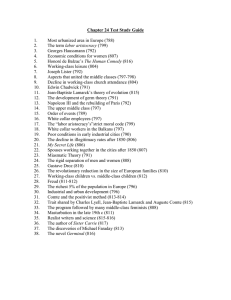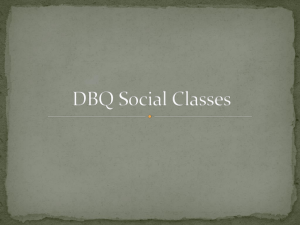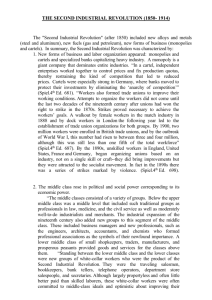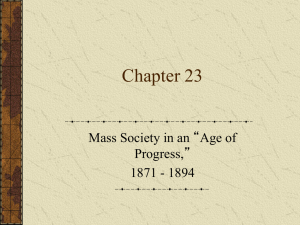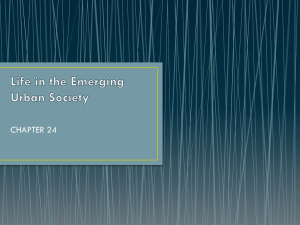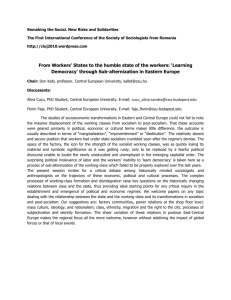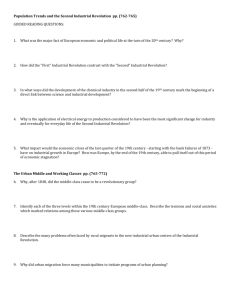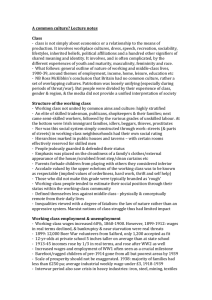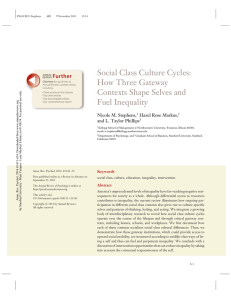Social Class Identities
advertisement
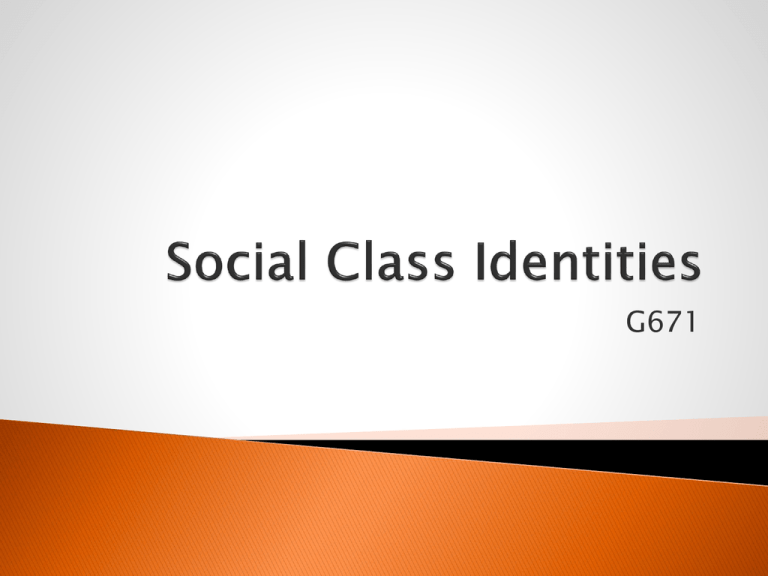
G671 What do we mean by social class? What social classes are there in the contemporary UK? What social class are you – and how do you decide? We tend to discuss social class in the UK in terms of three main classes: Upper Class Middle Class Working Class However, this gets more complex, as sociologists often divide the upper and middle classes into two types of each, and add a fourth class (the ‘underclass’). Other sociologists believe that the term ‘social class’ has no real meaning in the contemporary UK: It is an outdated concept. What social class are the following? A builder A teacher A plumber The Queen A lawyer Simon Cowell A surgeon A rapper A shop assistant A novelist A cleaner Bruce Wayne A waitress (Lord) Alan Sugar This means the social class you believe you are (or someone else is). It is based on your own opinion/view – linked to your own experiences and values. Upper Class Type of Education Accent/Way they speak What they do for fun What they wear Where they live Middle Class Working Class This is when a person social class is decided using some kind of pre-determined measurement... ...It could be seen as the social class that society has decided you are. In the UK, the social class of every household is measured objectively. The main factor used is a person’s OCCUPATION. Study the worksheet, which shows the classification system used. Answer the questions on the worksheet. CLASS 1 NAME OF CLASS Higher Managerial/ Professional EXAMPLE High Court Judge 1.1 1.2 Large employers Higher professional employers Senior Police Officer Solicitor 2 Lower Managerial/ Professional Nurse 3 4 5 Intermediate Small Employers Lower Supervisory/Technical Secretary Farmer, taxi driver Printer, plumber 6 Semi-routine Shop assistant, hairdresser 7 8 Routine Never worked/longterm unemployed Labourer, waiter Marx believed in two, conflicting social classes: The bourgeoisie (ruling classes) and the proletariat (working classes). Social class was identified through proximity to the means of production. Those closest to the means of production (e.g. workers in a factory) were the working classes, those furthest away (e.g. the owners of the factories) were the ruling classes. The ruling classes exploit the working classes by paying them a fraction of their worth and keeping the rest as profits. 1. 2. 3. Bourdieu was a Neo-Marxist, who used the concept of capital to identify social class differences. He claimed there were three types of capital people could possess. Some were ascribed and others achieved. Economic Capital (e.g. Income, wealth, inheritance) Cultural Capital (e.g. Knowledge and taste of the arts and other such pursuits) Social Capital (e.g. Social connections and group membership) Complete the cultural capital quiz, to find out how much cultural capital you have. http://www.youtube.com/watch?v=zInIRiBOp44 http://www.bbc.co.uk/news/uk-22007058 The BBC Lab UK (2013) study used Bourdieu’s concept of capital to identify a whole new way of categorising social class in the UK. For homework, read through the study and use to ‘class calculator’ to measure the class of someone in your household. Classes in the UK are fragmenting and changing. The boundaries between workingclass and middle-class are blurred due to: 1. Globalisation (e.g. migrant workers 2. 3. replacing the traditional working class) Consumer Culture (people ‘pick-and-mix’ their identities based on lifestyle choices) The growth of Popular Culture (pursuits previously associated with one class now popularised for the masses). Features of and changes to traditional social class identities. Traditionally, those involved in manual labour had a strong awareness of their social-class position. This awareness gave them a clear class identity and communities based on a shared culture. Willis (1977), in his Learning to Labour study identified aspects of this culture... Traditional gender roles Boys following in father’s footsteps Strong, united communities; distrust of outsiders Strong links with the Labour Party and trade unions Immediate gratification Rental housing in cheap, less-desirable areas (usually within walking distance of workplace). What aspects of working class culture were evident in the film The Full Monty? What type(s) of capital did the characters possess? Do you think this type of working-class culture still exists in the UK? Change More likely to work in the service sector and not in manual labour Women increasingly likely to be breadwinners Better off financially; own their own houses/cars etc. Shared responsibilities in the household Live more private family lives (less community based) More varied aspirations and ambitions Other? Reason The decline of heavy industries (coal, steel, shipbuilding etc). Areas that had specialised in these industries experienced massive unemployment. Growth of the service sector offering jobs previously more associated with middle-classes. Changing educational opportunities (education age raised; student loans system means university more affordable) Improved educational opportunities for girls More freedom and individualism promoted by society; less expectation on people to follow in parents’ footsteps. Mike Savage (2005) studied people in the traditionally working-class area of Cheadle. Found some elements of working-class culture (manual labour; community ‘feel’)... ...But most owned their own homes and cars, didn’t live near their work and had money to spend... ...41% of them had no clear class identity; 18% considered themselves middle class! http://www.youtube.com/watch?v=mIHeAOA1 3cw One of the biggest indicators of change in the working classes is the arrival of the ‘Underclass’... ...Although Karl Marx did hint at some kind of ‘underclass’, referring to them as the lumpenproletariat (those who would never realise they were being exploited). “The women are slags; either scrawny with straggly blonde hair, or grotesquely fat and bulging out of their tracksuit bottoms. The children are surly, whining, spoilt, wolfing down their junk food with no concept of manners and not much grasp of the English language...” (Ferdinand Mount; Conservative commentator; 2004) “Something has died in the working class: a sense of grace, community, intelligence, decency and wit. The salt of the earth have become the scum of the earth; a huge tribe of tattooed white trash.” (Tony Parsons; writer; 1999) The concept is often used in a derogatory way to describe individuals living in rundown housing estates, likely to be unemployed, single-parents, drug addicts etc. Many right-wing theorists like Murray (1990) link the underclass to criminality, idleness, a lack of education and lack of morals. They blame the welfare state for creating the underclass. What do we mean by a ‘welfare state’? Why do you think some people argue that the welfare state has created the underclass? Many disagree with such negative portrayals. Jordan (1992) argues that people living in poverty have the same values of work and family as everyone else and often feel ashamed at having to ask for help. Traditionally, those in professional positions; white-collar or non-manual occupations. The middle-classes are seen as welleducated and possessing cultural capital. Features of middle-class culture include: Social mobility Deferred gratification Home-ownership Social and cultural capital Have the middle-classes changed? If so, how? Embourgeoisement is the theory that the middle-classes are growing and the upper/working classes are disappearing. This is a Weberian view. Proletarianisation is the theory that the middle-classes are shrinking and we are returning to a polarised two-class society. This is a Marxist view. Rise in low-paid white-collar jobs (e.g. What class is a retail assistant?) More education opportunities Middle-class “split” into two. According to Savage (1992) this is based on lifestyle & employment e.g. private sector employees versus managerial/government employees. According to Devine’s study of doctors (2005), few willingly identified themselves in terms of social class. The upper-class is the smallest class group, and probably the least visible. They are divided into the traditional upper class (e.g. aristocracy) and the super-rich (e.g. People who have achieved wealth through hard work or fame – or even luck!). Both groups have economic and social capital; only the aristocracy have cultural capital. The traditional upper-class values tradition, hierarchy and order and operates a system of social closure. Aristocracy – ascribed status Land-ownership Intermarriage (marrying those from similar social backgrounds) Value tradition, hierarchy and order Socially-closed Tend not to flaunt wealth in the same way as the super-rich Achieved status Glamorous Lifestyles Use media to their advantage Value material possessions, brand names, labels Visibly rich lifestyle High social and economic capital; very little cultural capital. Write a 750-1000 word essay on the following: Outline and evaluate the extent to which traditional social classes have changed in the contemporary UK. G671 “How do you eat your dinner?” Mealtime Rituals The middle-classes are thought to sit down together to share a family meal; workingclass mealtimes happen earlier (to coincide with the end of work) and in front of the TV. A vital role of the Family is influencing class identities is in the passing down of capital. In pairs, identify three ways in which each different type of capital can be passed down through a family. What differences are there in the ability of a working-class family to pass down capital compared to an upper class one? Reay (1998) on Education: MC mothers can influence their children’s primary schooling more than WC mothers because: a) b) c) They have more time They know the system They had positive experiences of school This is an example of how families might influence cultural capital. King & Raynor (1981) found that childcentredness is a distinctive feature of middleclass families, especially in terms of passing on educational opportunities and attitudes required for educational success. Teenage Pregnancy The risk of becoming a teenage mother is ten times higher for a girl from a working-class background. Family background and poverty are key factors in girls’ decisions to become teenage mums, which they thought would give them purpose and identity (Cater & Coleman; 2006) How does the media represent different social classes? What stereotypes does it rely on? http://www.youtube.com/watch?v=WL ToN2pjik8 Programmes such as Shameless show the working-class as aggressive, assertive and sly. The Jeremy Kyle Show reinforces prejudices and negative views of the underclass, depicting them as irresponsible, deviant, aggressive, immoral and lazy. Medhurst (1999) found that middle-class students believed The Royle Family was an accurate portrayal of working-class life. http://www.youtube.com/watch?v=1KMrJGz3EIg The Super Rich Celebrities, like the Beckhams or the Osbournes, have used the mass-media to further their careers, raise their status etc. New Technology: In the 1990s, satellite dishes were regarded as a symbol of the working-class (Brundson; 1997). Are any social classes more religious than others? = of the Contrary to the Marxist view, there is evidence (from church attendance statistics) that working class people in the UK tend to be less religious than middle class people. However, this may not be accurate: Just because someone doesn’t go to church, doesn’t mean they don’t believe! You can “believe without belonging” (Davie; 1994) Some New Religious Movements like ‘Scientology’ attract wealthier people, as they are expensive to belong to. The Church of England (and other ‘big’ churches) tend to have a higher middle class following. Many religious cults also seem to have attracted predominantly disillusioned middle-class people. Other religions, such as Rastafarianism, have a mainly working-class base, as they are more common in inner-city communities. http://www.youtube.com/watch?v =KpThUUa3AeA http://www.youtube.com/watch?v =80XIao_l9TE The type of school you go to will indicate your class position (e.g. If you go to an expensive public school, you’re probably not working class! If you’re at Northampton College, you’re probably not upper class!) Old public schools are full of cultural signals that indicate class position (e.g. The buildings, the uniform, the crest...). Homework: Find and look around the Eton College website. Compare it to the Northampton College website: What similarities/differences do you see? Bourdieu (1977) claimed that schools were middle-class institutions, run by middleclass teachers for the benefit of middle-class students... ...They reinforced the middle-class values held in middle-class homes. Universities are even worse: A middle-class student is like a “fish in water” at university, whereas it is an isolating and daunting environment for a working-class student. The Formal Curriculum: A student who studies Latin, for example, will increase their cultural capital, having a different understanding of society to a student on a vocational course, with low cultural capital. Direct Pathways: Power (2003) showed that public schools actively encourage applications to elite universities, considering this a measure of their success. How many of your friends are from a different social class background to yourself? Some studies suggest that social class is very influential in the formation of peer group – cultural comfort zones: We tend to be drawn to people of the same social class background as ourselves. (e.g. A group of boys who play polo would not identify themselves as working class). Why? Social class also gives young people a shared identity; hence class identity can be crucial in the formation of subcultures (Brah; 1999) To what extent does where you work indicate your social class? The type of job you have is generally considered the biggest social class indicator. We know that scales like the RG and the NSSEC use this to measure class in the UK. Some ‘traditional’ links between work and class are changing as the nature of work in society changes. Traditionally, there have also been clear links made between the working-classes and the trade unions, who represent the rights of workers. Design and conduct a survey to find out the extent of class identity among a sample of young people. You need to find out things like: What social classes do they think exist? Do they think class is important? Do they feel they belong to any particular class? Use your findings (alongside some of what you have learned in this unit so far) to write an short essay on the following: Is Social Class still an important source of identity for young people in the UK today?
